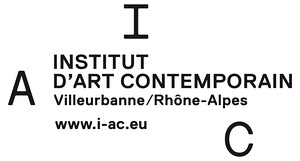station (1)0: Study days
November 4–5, 2016
11 rue Docteur Dolard
69100 Villeurbanne
France
T +33 4 78 03 47 00
F +33 4 78 03 47 09
Co-founded in 2009 by artist Ann Veronica Janssens and Nathalie Ergino, director of the Institute for Contemporary Art (IAC), the Laboratoire espace cerveau investigates theoretical and practical research that allow for the interconnection of space, time, body and brain.
Study days
Friday, November 4, 2–6pm & Saturday, November 5, 10am–1pm
Auditorium of the IAC
Guests:
Camille Chenais, project coordinator at Bétonsalon - Art and Research Center
Didier Debaise, doctor in Philosophy, researcher for the FNRS, teaches philosophy at the Free University of Brussels
Tran Minh Duc, artist in residence at The Living Academy
Pierre Montebello, philosopher, teaches modern and contemporary philosophy, Metaphysics and Aesthetics at Mirail University in Toulouse
Thierry Mouillé, artist & coordinator Laboratory Intuitions
Cyrille Noirjean, director Urdla & psychanalyst
Gyan Panchal, artist, resident researcher in ESACM (School of Art Clermont Métropole)
Pascal Pique, curator and founder of The Museum of Invisible
Alexandre Wajnberg, science journalist
Launching of the “towards a cosmomorphic world” programme:
Ever since 2009, the Lab has been providing us with a variety of ever-renewed approaches both on space itself and on space as a possible extension of the eye, the brain or the body. It has up to this day been primarily concerned with the study of the mechanisms of perception: spatialisation, loss of landmarks, altered states of consciousness. New ways of defining our relation to space, our apprehension of the world through sensory experiments, have emerged. By delineating a new “field of passage”—from perception to fusion, from immersion to osmosis—the Lab now opens up a new research cycle with stage (1)0. Its aim is to examine the interrelations between man and its environment—in the widest possible meaning of the term—towards a cosmorphic word.
From stage (1)0 on, the Lab initiates a new cycle, widening the scope of its research field in such a way as to include the organic bonds that connect man with cosmos. Issues raised by the Anthropocena are indeed a strong incentive for man to acknowledge its relative position within the life chain. The dramatic, now unquestionable, shifts in biology, geology and climate, combined with the outcome of recent scientific studies, all point to the necessity of reconstructing a human, and a non-human, world. This growing awareness induces fundamental changes in our relationship to the world: the dual principles behind the Western approach—which consists in tearing man apart from nature, and opposing matter and mind—give way to a cosmologic pattern, a vision of the world that is no longer anthropomorphic but “cosmomorphic.” Recent scientific developments (in neurosciences, in astrophysics, in biology, in geology) prompt us to re-examine the boundaries between body, space, time, and brain, and to “broaden” our perception of the environment, somewhere between the infinitely large and the infinitely small. The new lines of research developed by scientists contribute to the present renewal of interest in the bonds connecting us with Earth, the recreation of the ties between matter and life, and the inscription of man within cosmos.
After the experiments in “enlarged perception,” we are now led to experience even more intense ones, such as the vital fusion with the elements, the yearning for oneness with the Universe. In the wake of new research on the life chain—as for instance in epigenetics, where the environmental impact on the genome has been measured over several generations, or in astrology, where common ground between Mars and the Earth has been searched for within the scale of the infinitely small—we are inclined to think in terms of coexistence and dynamic links.
From such a transitive, relational approach may emerge the fundamental notions of milieu, passage and motion. A unified apprehension of cosmos arises, after the fashion of Oriental conceptions, deprived of any form of cleavage.
How can creation and research contribute today to this change in paradigm and establish a new way of looking at the world? Could a common responsibility, shared by artists, scientists and intellectuals, pave the way for alternative action?
–Nathalie Ergino
Initiators:
Ann Veronica Janssens, artist
Nathalie Ergino, director of the Institut d’art contemporain, Villeurbanne/Rhône-Alpes
Participants (since 2009):
Elisa Brune, writer (novelist and essayist) and science journalist
Denis Cerclet, antropologist, lecturer at Université Lumière Lyon 2
Arnauld Pierre, art historian, professor at Université Paris IV-Sorbonne
Jean-Louis Poitevin, has a doctorate in philosophy and is a writer and art critic
Participant artists (since 2016):
Clarissa Baumann; Benjamin Blaquart; FRAME (Alys Demeure, Sandra Lorenzi, Stéphanie Raimondi, Héloïse Lauraire, Jérôme Grivel); Célia Gondol; Lola Gonzàlez; Linda Sanchez; Vahan Soghomonian; Mengzhi Zheng
Works for study:
Clarissa Baumann, Hicham Berrada, Benjamin Blaquart, Michel Blazy, James Lee Byars, Gilles Clément, Walter De Maria, Tony Di Napoli, Hubert Duprat, FRAME, Hamish Fulton, Célia Gondol, Lola Gonzàlez, Jérôme Grivel, Pierre Huyghe, Joan Jonas, Barbara et Michael Leisgen, Antti Lovag, Helen Mirra, Matt Mullican, Otobong Nkanga, Katie Paterson, Abraham Poincheval, Evariste Richer, Linda Sanchez, Vahan Soghomonian & Tomi Yard, TAKIS, Charwei Tsai, James Turrell, Maarten Vanden Eynde, Mengzhi Zheng
Last days of Jason Dodge’s exhibition Behind this machine anyone with a mind who cares can enter.
November 5, 4:30pm: visit of the exhibition and launch of Jason Dodge’s new artist edition.
November 6, 4pm: reading by the American poet Matthew Dickman.
November 6, 4pm: launch of Jason Dodge’s new artist book Ready To Get Bleeding.
further information here


